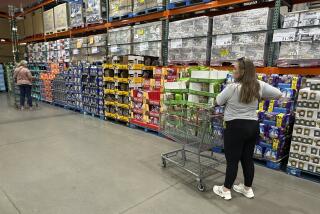New-Home Sales Surge 15% in Buying Frenzy
- Share via
Buyers rushing to beat rising U.S. mortgage rates pushed new-home sales up by nearly 15% to a record in May, while businesses saw weaker demand for long-lasting durable goods, government reports showed Thursday.
The Commerce Department said sales of new homes surged a whopping 14.8% -- their biggest monthly gain since April 1993 -- to a record annual rate of 1.37 million units.
A separate report from the Commerce Department showed orders for durable goods, which are items meant to last three years or more, posted an unexpected drop in May, falling 1.6% after a 2.6% slide in April.
This was the first time since November-December 2002 there were back-to-back decreases in orders.
Meanwhile, the Labor Department said the number of Americans seeking jobless benefits rose more than expected last week. However, the number was elevated by claims from those who were unable to file when government offices were closed for the June 11 funeral for former President Reagan.
The private sector Conference Board had better news on the job front, saying its index of U.S. help-wanted advertising rose to 39 in May from 38 in April.
Economists said the reports showed the U.S. economy was continuing its rebound from the 2001 recession but was showing signs, after three quarters of sizzling growth, of cooling down to a more sustainable pace.
“Some kind of reasonable cool-down could be welcome,” said Anthony Karydakis, senior financial economist at BancOne Capital Markets in Chicago.
A solid but not overheated growth rate would comfort Federal Reserve officials, who are set to meet Tuesday and Wednesday amid widespread expectations they will raise short-term interest rates in an attempt to head off inflation.
The prospect of higher short-term rates has already had its effect on mortgage costs.
The average interest rate on a conventional 30-year mortgage was 6.27% in May, according to mortgage finance giant Freddie Mac. That was the first month since September 2003 it had been above 6%.
The belief that rates are going to keep rising often drives potential buyers into the market as they try to lock in lower rates -- a phenomenon economists call the “fence-sitter effect.”
BancOne’s Karydakis said buyers jumping off the fence and into the market might provide a brief boost for home sales but rising rates would finally start to weigh on them.
More to Read
Inside the business of entertainment
The Wide Shot brings you news, analysis and insights on everything from streaming wars to production — and what it all means for the future.
You may occasionally receive promotional content from the Los Angeles Times.










